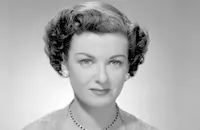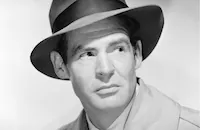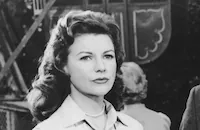The Woman on the Beach

Brief Synopsis
Cast & Crew
Jean Renoir
Joan Bennett
Robert Ryan
Charles Bickford
Nan Leslie
Walter Sande
Film Details
Technical Specs

Synopsis
After waking up from a battle-inspired nightmare, Lieutenant Scott Burnett, a mounted patrolman in the United States Coast Guard, confides to his friend, Otto Wernecke, that his naval war experiences have left him deeply disturbed. Scott also fears his attraction to Peggy Butler, a beautiful married woman he sees during his daily patrol and who is part of his recurring nightmare. Scott asks his girl friend, Eve Geddes, to marry him that night, and though she agrees at first, she later convinces Scott to wait another two weeks. Scott then sees Peggy on the beach collecting wood from an abandoned shipwreck, and stops to talk with her. When a tense Scott tells Peggy not to take the wood, she surmises that he is haunted by memories of a torpedoed ship and invites him to her house. There Peggy advises Scott to rid himself of his "ghosts" by not fighting them and impresses him with her understanding and compassion. Peggy and Scott's tender exchange is interrupted by the arrival of Peggy's husband Tod, a blind, renowned artist. Sensing Peggy's excitement, Tod invites Scott to stay, but he is anxious to go and returns to his station. Later that night, Tod shows up at the station and insists that Scott have dinner at his house, and Scott, who is supposed to meet Eve in town, agrees. During dinner, Scott and Tod discuss Tod's blindness, which has robbed him of his livelihood and forced him into an isolated, embittered existence with Peggy. Later, Peggy confesses to Scott that she stays with Tod because she accidentally cut his optic nerve during a drunken fight and therefore feels responsible for him. Scott, however, doubts Tod's blindness is genuine and kisses Peggy. The next day, when Eve drops by Scott's station to ask him about the previous night, he becomes angry and tells her that he is too sick to marry her. Scott then finds Peggy at the shipwreck and shares another passionate kiss with her. When Tod wanders by the wreck, seemingly aware of their presence, Scott insists that he can see and asks Peggy to leave Tod if he proves that he is not blind. After Peggy agrees, Scott invites Tod to walk with him to the cliffs and deliberately abandons him at the edge. Tod tumbles over, but only suffers bad bruises. From Tod's doctor, Scott learns that Peggy had once been involved with Eve's deceased brother and confronts her about it. Her cavalier admission of guilt convinces Scott to tell Tod the truth about the cliff incident, and Tod accepts his apologies and offers to show him some of his paintings. When Tod realizes that Peggy, who wants him to sell his valuable paintings so that they can live better, has removed her portrait, he demands that she return it immediately. As he leaves, Scott hears Tod slapping Peggy repeatedly and later finds her waiting for him at the shipwreck. Determined to rid Peggy of Tod, Scott invites him to go deep sea fishing as a fierce storm approaches, and Tod accepts. Once at sea, Scott confronts Tod about Peggy and hits him. In the ensuing fight, Scott falls overboard, but is rescued by the Coast Guard, who have been alerted by Peggy. Although Tod is furious at Scott's attack, he realizes that Peggy loves him and decides to "free" her by setting their house on fire. After his paintings go up in flames, Tod gives Peggy and Scott his blessing and heads for New York.

Director

Jean Renoir
Cast

Joan Bennett

Robert Ryan

Charles Bickford

Nan Leslie

Walter Sande
Irene Ryan

Glenn Vernon
Frank Darien
Jay Norris
Hugh Chapman
Carl Faulkner
Maria Dodd
Harry Harvey
Charles Pawley
Robert Andersen
Drew Miller
Robert Manning
Bill Shannon
Harry Tyler

Donald Gordon
Jackie Jackson
Carl Armstrong
John Elliott
Bonnie Blair
Carol Donell
Kay Christopher
Nancy Saunders

Martha Hyer
Crew
C. Bakaleinikoff
Lyle Boyer
James Casey
Russell A. Cully
Albert S. D'agostino
Frank Davis
Hanns Eisler
Charles H. Gardiner Lt. Comm., U.s.c.g.r.
Gil Grau
Jack J. Gross
Roland Gross
Michael Hogan
Walter E. Keller
Harold Palmer
John Pommer
Clem Portman
Will Price Assoc Prod
Jean Renoir
Leonard Shannon
Darrell Silvera
Jean L. Speak
Edward Stevenson
John Sturtevant
Leo Tover
Paula Walling
Harry Wild

Videos
Movie Clip


Hosted Intro
Film Details
Technical Specs

Articles
The Woman on the Beach
Originally slated as a tantalizing project for famous horror producer Val Lewton under the title Desirable Woman (and loosely based on the Mitchell Wilson potboiler None So Blind), Woman on the Beach became Renoir's fifth and final American film when he was brought on at the request of Bennett. The cast went through several changes, with George Brent originally slated as the lead before Ryan came on board. As the prestige value escalated both behind and in front of the camera, the film evolved from a quickie programmer to an A-list project.
Bennett (who was fluent in French) and Renoir got along famously on the set; Renoir was particularly amused by the contrast between her vamp image and far homier off screen persona. As he wrote to his friend Paul Cezanne, "She spends the whole day knitting, and I find it really funny to think that this homey person is considered by the American moral groups to be the most dangerous sexpot on the screen today." In another letter to Marie Lestringuez he wrote, "She knows how to make fun of her screen personality and doesn't waste a single ironic allusion to her false eyelashes or any other artifices of make-up. The other actors, camera crew, technicians also form an excellent company, the sort that has me returning home from this adventure almost regretting that it's going to end."
Unfortunately RKO brass and preview audiences at a disastrous Santa Barbara screening were left cold by the film's refusal to play by the traditional murder-mystery rulebook. A frustrated and despairing Renoir returned to the editing room and then reshot numerous scenes at RKO's insistence for a drastic overhaul, which probably accounts for several noticeable inconsistencies in the dialogue. As he wrote in a letter to Alain Renoir, "There was a lot of bad blood and I worked like a galley slave editing and re-editing. Now I've decided to stick with the current structure, which will still take me another two weeks to complete." After working on salvaging the film for a full year, his opinion of the work had dwindled considerably: "It was this miserable plot which RKO decided to give me to direct. I accepted, I don't know why, no doubt in order to pay my taxes, and it added a few miles of film to our good city's annual output." Later admitting "I'm afraid I was too far ahead of the public's mentality" in his autobiography, My Life and My Films, Renoir fortunately managed to preserve the essence of a challenging, complex, and very adult drama bound to surprise anyone expecting the usual duped hero and deadly dame formula. When the film received its expected lukewarm reception, Renoir¿s contract with RKO was terminated and he had to abandon a proposed adaptation of Madame Bovary. Meanwhile Bennett rejoined Lang the following year for another widely misunderstood thriller, Secret Beyond the Door, and soon teamed with another legendary French director, Max Ophuls, for 1949's The Reckless Moment.
Though he possessed American naturalization papers, Renoir found the studio experience so disheartening he opted out of becoming an American citizen and attempted an independent distribution company, the Film Group, which was stymied by an inability to secure loans. By the close of the decade, with his studio career officially over, Renoir turned instead to an independent source for his 1951 masterpiece, The River, commencing a decade-long fling with wildly colorful impressionist films that reinstated his critical standing with the international community once again.
Producer: Jack J. Gross, Will Price
Director: Jean Renoir
Screenplay: Frank Davis, J.R. Michael Hogan, Jean Renoir, Mitchell Wilson (novel)
Cinematography: Leo Tover, Harry J. Wild
Film Editing: Lyle Boyer, Roland Gross
Art Direction: Albert S. D'Agostino, Walter E. Keller
Music: Hanns Eisler
Cast: Joan Bennett (Peggy Butler), Robert Ryan (Lieutenant Scott Burnett), Charles Bickford (Tod Butler), Nan Leslie (Eve Geddes), Walter Sande (CPO Otto Wernecke), Irene Ryan (Mrs. Mary Wernecke).
BW-71m. Closed captioning.
by Bret Wood

The Woman on the Beach
Quotes
Trivia
Notes
The working titles of this film were None So Blind and Desirable Woman. Hollywood Reporter news items add the following information about the production: George Brent was announced in August 1945 as the film's star, and in January 1946, Hollywood Reporter announced that Virginia Huston, who is listed in the CBCS in the role of "Eve," would be making her screen debut in the film. Nan Leslie, however, who is credited in the CBCS as playing "Alice," appeared as Eve. Exteriors were shot at Sequit Point in Southern California. Added scenes were filmed at RKO's Culver City lot. According to files in the MPAA/PCA Collection at the AMPAS Library, PCA director Joseph I. Breen deemed the film's story to be "unacceptable under the provisions of the Production Code, in that it is a story of adultery without any compensating moral values." Despite Breen's repeated objections concerning the story's love triangle and his admonitions that "Scott" not be shown kissing married "Peggy," the film was eventually approved with little alteration.
In his autobiography, director Jean Renoir recalls that he was supposed to co-write the screenplay with executive producer Jack J. Gross, but that Gross died before the script's completion. Gross, however, did not die until 1964. The producer to whom Renoir was referring could have been Charles Koerner, the head of production at RKO, who died on February 2, 1946 after a bout with leukemia, or to producer Val Lewton, who did not die but, according to Hollywood Reporter, was fired from the picture during pre-production. Renoir notes that the film was "the sort of avant-garde film which would have found its niche a quarter of a century earlier...but it had no success with American audiences. Worse still, it thoroughly displeased the RKO bosses. I was under contract to make two films for that company. A few days after the premiere I had a visit from my agent...who reported that they were ready to buy me out for a fixed sum....I never made another film in an American studio." Modern sources note that Joan Bennett requested that Renoir direct the picture, and that, following a disastrous preview in Santa Barbara, RKO executives brought in another screenwriter and demanded that Renoir reshoot half of the film. According to Hollywood Reporter, additional shooting was done in December 1946.















